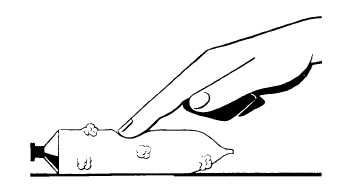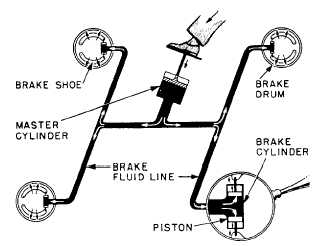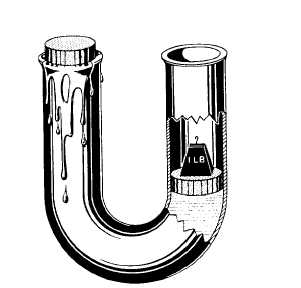Figure 10-5.-Pressure to a fluid transmits in all directions.
PRINCIPLES OF HYDRAULIC PRESSURE
A Frenchman named Pascal discovered that a
pressure applied to any part of a confined fluid transmits
to every other part with no loss. The pressure acts with
equal force on all equal areas of the confining walls and
perpendicular to the walls.
Remember when you are talking about the
hydraulic machine, you are talking about the way a
liquid acts in a closed system of pipes and cylinders. The
action of a liquid under such conditions is somewhat
different from its behavior in open containers or in lakes,
rivers, or oceans. You also should keep in mind that you
cannot compress most liquids into a smaller space.
Liquids don’t “give” the way air does when you apply
pressure, nor do liquids expand when you remove
pressure.
Punch a hole in a tube of toothpaste. If you push
down at any point on the tube, the toothpaste comes out
of the hole. Your force has transmitted from one place
to another through the toothpaste, which is a thick, liquid
fluid. Figure 10-5 shows what would happen if you
punched four holes in the tube. If you were to press on
the tube at one point, the toothpaste would come out of
all four holes. You have illustrated a basic principle of
hydraulic machines. That is, a force applied on a liquid
transmits equally in every direction to all parts of the
container.
We use this principle in the operation of four-wheel
hydraulic automobile brakes. Figure 10-6 is a simplified
drawing of this brake system. You push down on the
brake pedal and force the piston in the master cylinder
against the fluid in that cylinder. This push sets up a
pressure on the fluid as your finger did on the toothpaste
in the tube. The pressure on the fluid in the master
cylinder transmits through the lines to the brake
cylinders in each wheel. This fluid under pressure
Figure 10-6.-Hydraulic brakes.
Figure 10-7.-Liquid transmits force.
pushes against the pistons in each of the brake cylinders
and forces the brake shoes out against the drums.
MECHANICAL ADVANTAGES OF
HYDRAULIC PRESSURE
Another aspect to understand about hydraulic
machines is the relationship between the force you apply
and the result you get. Figure 10-7 will help you
understand this principle. The U-shaped tube has a
cross-sectional area of 1 square inch. In each arm is a
piston that fits snugly, but can move up and down. If you
place a 1-pound weight on one piston, the other one will
push out the top of its arm immediately. If you place a
10-5





